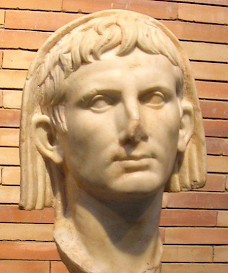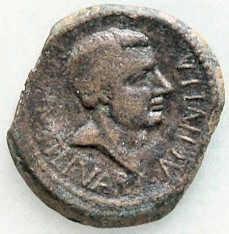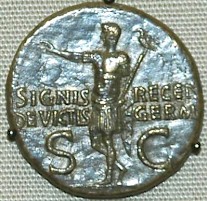Legio XIX
Legio XIX: one of the Roman legions. Its surname is not known, but may have been Gallica or Germanica.

Due to the fact that they were destroyed in the battle in the Teutoburg Forest in September 9, the history of the legions XVII, XVIII and XIX is not well understood. During the civil war of 49-48, both Julius Caesar and Pompey the Great employed legions with these numbers, but we do not know what became of them. It has been argued that the Caesarian legions, commanded by Curio, were destroyed in Africa, but this is entirely hypothetical.
It is more probable that the Nineteenth was founded in 41 or 40 BCE, after the battle of Philippi (where Caesar's murderers Brutus and Cassius were defeated). Its founder must have been Caesar's heir Octavian, who needed new units to put an end to Sextus Pompeius' occupation of Sicily, which put the grain supply of Rome into peril.
The first generation of soldiers may have consisted of veterans of the army of Brutus and Cassius that were included in the army of their former opponents. Others must have been recruited in Etruria, where in the year 30 BCE, veterans of the Nineteenth were settled in the neighborhood of Pisa.
Although Octavian is the most probably founder of this unit, it can certainly not be excluded that it was in fact founded by Mark Antony, his fellow-triumvir. He struck coins commemorating a nineteenth legion, which was surnamed Classica ("seaborne"). However, this is less likely.
When Sextus Pompeius was defeated, Octavian and his fellow-triumvir Mark Antony fell out with each other and started a war, which culminated in the naval battle off Actium (31), where Octavian defeated his opponent and won the supremacy in the Mediterranean world. From now on, he was known as the emperor Augustus.
It is possible, but again hypothetical, that the Nineteenth was stationed in Aquitania after the battle off Actium. An iron catapult bolt point found at Döttenbichl (near Oberammergau in Bavaria) suggests that later, the nineteenth legion belonged to the Roman army that conquered Raetia (after 15 BCE). A substantial part of the Nineteenth was at Dangstetten on the Upper Rhine between c.15 BCE and c.8 BCE. Its commander was, at that moment When Sextus Pompeius was defeated, Octavian and his fellow-triumvir Mark Antony fell out with each other and started a war, which culminated in the naval battle off Actium (31), where Octavian defeated his opponent and won the supremacy in the Mediterranean world. From now on, he was known as the emperor Augustus.

It is possible, but again hypothetical, that the Nineteenth was stationed in Aquitania after the battle off Actium. An iron catapult bolt point found at Döttenbichl (near Oberammergau in Bavaria) suggests that later, the nineteenth legion belonged to the Roman army that conquered Raetia (after 15 BCE). A substantial part of the Nineteenth was at Dangstetten on the Upper Rhine between c.15 BCE and c.8 BCE. Its commander was, at that moment, Varus.

In Germania, the soldiers part in the campaigns in Germania of Augustus' general Tiberius (8 BCE and 4-5 CE). The nineteenth legion was probably initially based in towns like Cologne and Neuss, and later transferred to (perhaps) Oberaden and (certainly) Haltern, where a lead ingot has been found that mentions this unit. However, there is not sufficient prove to be more precise. In 5 CE, the conquest of Germania was completed and Augustus sent Publius Quinctilius Varus to rule the area as a governor, impose tribute and establish civil rule.

In late 6 CE, Tiberius was to lead at least eight legions (VIII Augusta from Pannonia, XV Apollinaris and XX Valeria Victrix from Illyricum, XXI Rapax from Raetia, XIII Gemina, XIV Gemina and XVI Gallica from Germania Superior and an unknown unit) against king Maroboduus of the Marcomanni in Czechia; at the same time, I Germanica, V Alaudae, XVII, XVIII and XIX were to move against Czechia as well, attacking it along the Elbe. It was to be the most grandiose operation that was ever conducted by a Roman army, but a rebellion in Pannonia obstructed its execution.
It took three years to suppress the revolt. In these years, the Nineteenth was still with Varus. In September 9, however, the Cheruscan leader Arminius, one of Rome's most loyal allies, turned himself against the governor. When reports arrived that a western tribe had revolted, Varus, unaware of Arminius' treason, followed his advise to return to the Rhine. His army was trapped in the neighborhood of Osnabrück in the Teutoburg Forest (September 9 CE). The seventeenth, eighteenth and nineteenth legions were completely destroyed.

In 15, the eagle of the nineteenth was recovered by the Roman commander Lucius Stertinius among the Bructeri.
The legionary emblem of legion XIX is not known.
Literature
-
R. Wiegels, "Legiones XVII, XVIII, XIX", in: Yann Le Bohec, Les légions de Rome sous le Haut-Empire (2000 Lyon) 75-81